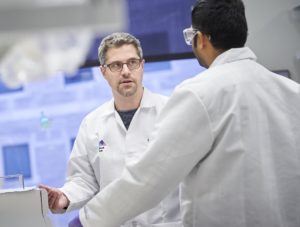
When MRSA hits your hospital, what do you do?
If you’re located in Europe or other places where infection rates are still relatively low, you can take a seek-and-destroy approach, isolating an affected patient and working out in concentric circles to identify contacts and potential transmissions.
If you’re in New York City, however, the strategy is not so simple. Hospital-associated infections with methicillin-resistant Staphylococcus aureus are endemic in the Big Apple, and this has required a fresh approach to treat and prevent the costly bacterial menace.
At Mount Sinai Hospital, the strategy now involves SMRT Sequencing. Established in 2013, the Mount Sinai Pathogen Surveillance Program has sequenced more than 2,000 genomes, cataloging around 43,000 isolates from 22,000 patients. While its original role was in reactive outbreak investigation, it is now also used as a tool for proactive, continuous infection surveillance for common hospital pathogens.
As previously reported in this blog post and this webinar, adding SMRT Sequencing to routine surveillance of MRSA and C. difficile throughout the hospital has provided a more comprehensive view of drug resistance and revealed new pathogenic strains and unexpected transmission paths.
We recently caught up with Harm van Bakel, Assistant Professor of Genetics and Genomic Sciences, Icahn School of Medicine at Mount Sinai, to learn more about how the program has evolved and some of the results published in this paper.
Why did you choose SMRT Sequencing?
MRSA is highly clonal. Traditional molecular strain typing methods, such as pulsed-field gel electrophoresis (PFGE), S. aureus protein A (spa) typing, and multilocus sequence typing (MLST), can facilitate rapid screening, but their resolution is limited, and they are unable to capture genetic changes that lead to alteration or loss of typing elements.
As a result, short-read whole genome sequencing has emerged as the gold standard for studying lineage evolution and nosocomial outbreaks. By comparing sequences of your clone of interest to a reference genome, you are able to profile changes in the core genome. However, you may still be missing crucial information contained in non-conserved ‘accessory’ genome elements, which harbor a lot of virulence and drug resistance determinants, and evolve more rapidly.
These accessory elements, which include endogenous prophages, mobile genetic elements, and plasmids, are very repetitive in nature, so long-read sequencing that is able to resolve these was needed to help us determine what’s going on in both the core and accessory genome elements. It also gives us additional information to tease apart the evolution of an outbreak.
In the paper, we gave an example of a persistent outbreak in the hospital’s neonatal intensive care unit, which was eventually traced to adult hospital wards, with ventilators as a potential vector. Long-read sequencing enabled comparative genome and gene expression analyses of the outbreak clone to hospital background strains, in which we identified genetic and epigenetic changes, including acquisition of accessory genome elements that may have contributed to the persistence of the outbreak clone.
What lessons have you learned from continuous surveillance?
 Logistically, we have learned that integration and automation are key. In the beginning, we were a little naive. But we quickly realized that you can’t just analyze the genomes in a vacuum. Just identifying infection relatedness between two patients isn’t enough either. You have to understand how certain strains may have spread between patients. This requires detailed information about the patient’s condition, where they have been in the hospital, which staff and equipment they have come in contact with. We had to develop bioinformatics tools to layer genetic information on top of patient and hospital epidemiologic records to create a single, integrated map. We’ve found we need an entire support system in addition to the sequencing in order to make it work. We’re fortunate that our health system has the centralized testing and medical records systems to help us operate in an efficient manner.
Logistically, we have learned that integration and automation are key. In the beginning, we were a little naive. But we quickly realized that you can’t just analyze the genomes in a vacuum. Just identifying infection relatedness between two patients isn’t enough either. You have to understand how certain strains may have spread between patients. This requires detailed information about the patient’s condition, where they have been in the hospital, which staff and equipment they have come in contact with. We had to develop bioinformatics tools to layer genetic information on top of patient and hospital epidemiologic records to create a single, integrated map. We’ve found we need an entire support system in addition to the sequencing in order to make it work. We’re fortunate that our health system has the centralized testing and medical records systems to help us operate in an efficient manner.
Scientifically, we have learned that there’s a lot more happening under the surface than we were aware of — in regards to strain types, evolution, frequency, virulence and transmission. We continue to see under-the-radar outbreaks that we wouldn’t be aware of without a sequencing-based surveillance program. And we’ve learned that MRSA can be colonized for a long time and re-emerge weeks, if not months later, when infected patients return to the hospital.
The continuous surveillance has led to a much better understanding of how pathogens circulate throughout the hospital. It allows us to be more proactive. In some cases, it has led to interventions in certain wards. In the case of the NICU outbreak, if we had implemented continuous sequencing before it occurred, we may have been able to intervene much sooner.
What’s next?
We want to continue to improve the program so that it’s fast and cost effective enough to inform infection prevention. Not only does this benefit patient care, but it can help avoid larger outbreaks, ward closures, and other costs associated with investigating and reacting to infections.
We also want to build a more comprehensive view of all pathogens, so we have started to track viral pathogens too, including influenza.
And we have expanded the program beyond just Mount Sinai Hospital, into the entire Mount Sinai Health System, including other hospitals and community care facilities that cover most of the Manhattan area. We hope this will help us understand just how pathogens are moving throughout the system as patients travel from facility to facility, and to detect new pathogens emerging from the community.
We can’t make headway into reducing the MSRA endemic unless we understand it better. We need to better map the route of transmission of the pathogen between people, and in the environment. This is only possible through hospital-wide – and ideally region-wide – surveillance.